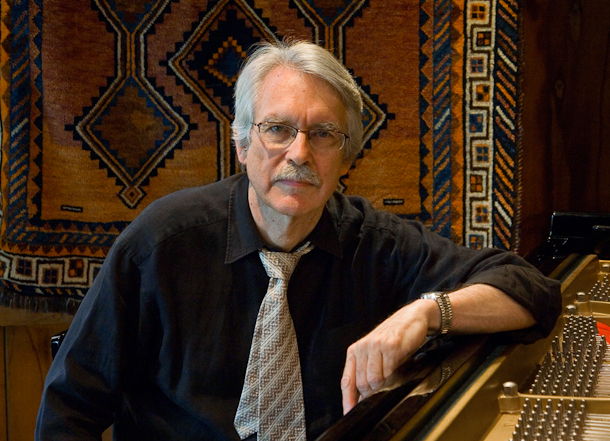The shade of Levine hovers over new Harbison symphony

John Harbison's Symphony No. 6 will receive its world premiere Thursday night by conductor David Zinman and the Boston Symphony Orchestra.
When the Boston Symphony Orchestra launches into the world premiere of John Harbison’s Symphony No. 6 Thursday night, the man most responsible for the work and its principal inspiration will not be there.
James Levine, music director of the BSO from 2004-2011 commissioned the work from Harbison, a composer he has long been a steadfast advocate for, and the Sixth Symphony bears the inscription, “to James Levine in friendship and gratitude.”
So, is the new symphony merely inspired by the commissioning of the long-ailing Levine or is it an actual musical portrait of the conductor?
“I think it’s probably both,” said Harbison, from his Cambridge home, noting that the score changed markedly from what he had originally planned.
“The character of it seemed to be . . . out of harmony with the sense of Mr. Levine’s current situation where he’s had to give up so much of what he wanted to do,” said the composer. “I kind of went back and reconstructed the sequences of events and eliminated some things and put some other things in.”
“I’d say I made it more attuned to the occasion. It was a piece for a concert that he was supposed to be conduct and that he is now not able to conduct.”
It was his original first movement especially, which Harbison felt seemed “least appropriate” with subsequent events. “It was a very self-assured, aggressive piece,” he says. “And I felt like I couldn’t find the character of the piece moving away from that vantage point. I also felt like it was the kind of movement I had written before.”
Harbison wound up losing a key sketch of that original movement, but forged ahead, which actually produced even more serendipitous results, he believes. “It had somehow fallen into my piano. I was convinced that I needed to have it to be able to refer to it directly.
“But by the time I found it I had been working with [the material] quite consistently so I realized it was all right. It actually never appears in the revised piece. It plays a big role but didn’t need to appear in its original form.”
Cast in four movements, Harbison’s symphony now begins with a setting of a poem by James Wright, Entering the Temple in Nîmes, for mezzo-soprano, and scored for smaller forces than the rest of the symphony.
The first movement with mezzo-soprano sets forth all the main ideas of the piece, while the ensuing movements all reflect back on the first movement in different ways. “The second movement expands and makes longer phrases while the third movement reduces things to very short components,” says the composer. “But it’s really the same material,”
In addition to the unusual device of employing a vocal soloist in only the first movement, the new symphony also contains some offbeat instrumentation, most notably the use of a cimbalom.
“There are moments in three of the movements when I was hearing a really specific sound that I thought sounded like a combination of percussion instruments,” Harbison explains. “But I wasn’t quite sure how I was going to produce it. I had initially sketched these moments for a prepared piano.
“I went to a performance at Tanglewood that had a cimbalom and a subsequent demonstration by Nick Tolle. And I liked his playing very much and so that had a very specific role in the psychology of the piece.”
One thing the 73-year-old composer noticed during the difficult creative process of this work is that he has tried to avoid repeating himself. “I don’t feel the need to try to revisit,” he said. “In fact I noticed as I was working on this piece that there was a sort of family relationship between the last movement of the First [Symphony] and the last movement of the Third. And I thought I don’t want to go anywhere near that again.”
The mutable nature of the symphony extended even to the order of the two inner movements, which Harbison was undecided about for a long time (as was Mahler with his own Sixth Symphony). “I understand that exactly. But it’s not a bad feeling. There’s a certain moment when you’ve finished doing something, when you sort of throw it all up in the air and watch it come down.”
This week’s performances of the Sixth Symphony will conclude the BSO’s two-season survey of Harbison’s complete works in the genre. But the laconic composer finds it difficult to characterize his Sixth Symphony as an entity or in relation to those previous works.
“It may be a good thing that I can’t say much about it,” he says. “Or it may be a bad thing. It will take a while for that to be figured out.”
Harbison said perhaps conductor David Zinman, a regular collaborator who is leading this BSO premiere, had the most prescient comment on the new symphony.
“He knows my orchestral music as well as anybody. And his main response to it was ‘It’s strange.’ And I was perfectly all right with that.”
David Zinman leads the Boston Symphony Orchestra 8 p.m. Thursday in the world premiere of John Harbison’s Symphony No. 6 with Paula Murrihy, mezzo-soprano. The program will also feature Weber’s Overture to Euryanthe, Strauss’s Till Eulenspiegel’s Merry Pranks, and Beethoven’s Piano Concerto No. 1 with Leif Ove Andsnes as soloist. The program will be repeated 1:30 p.m. Friday, and 8 p.m. Saturday and Tuesday. bso.org; 617-266-1200
Posted in Articles
